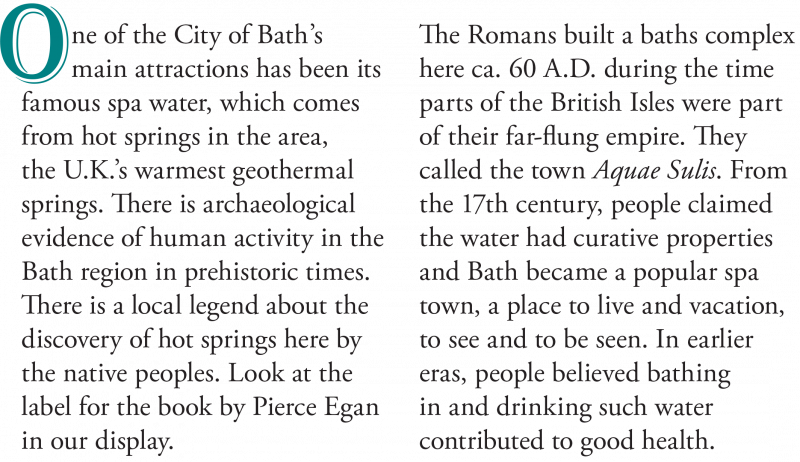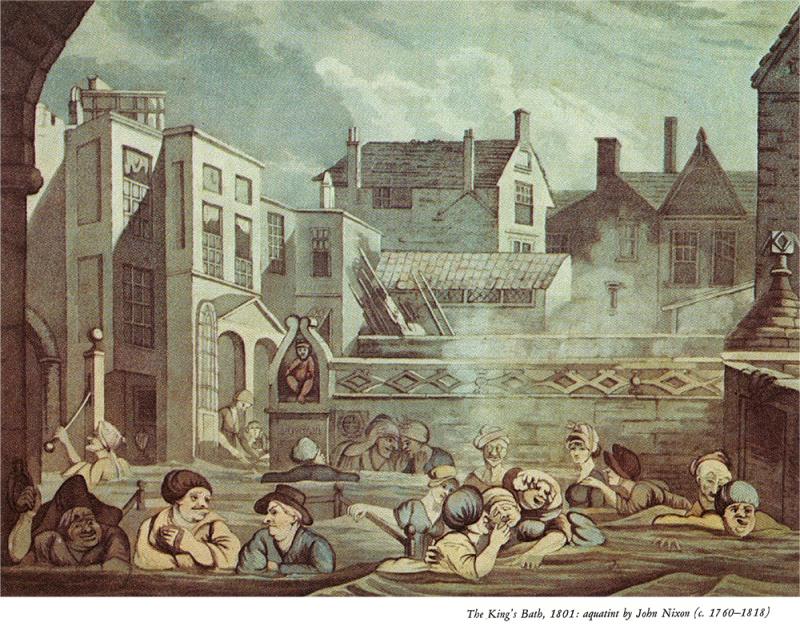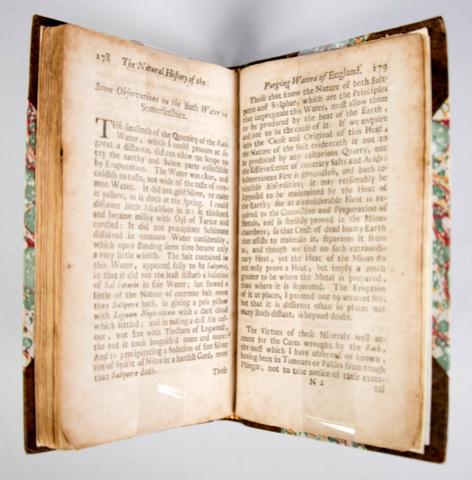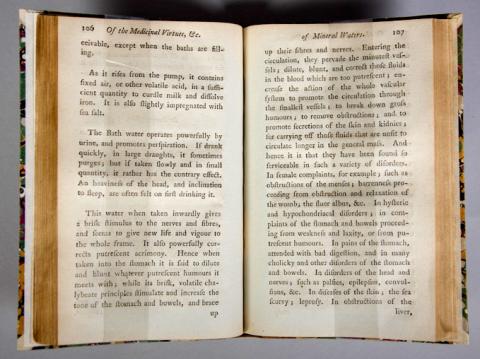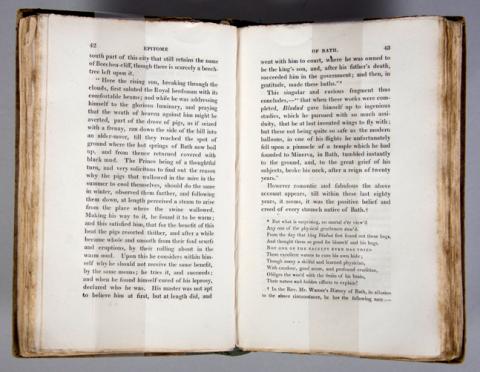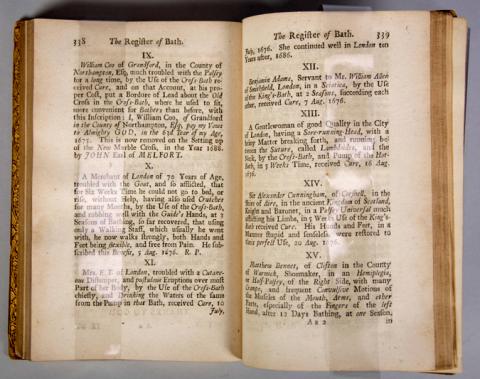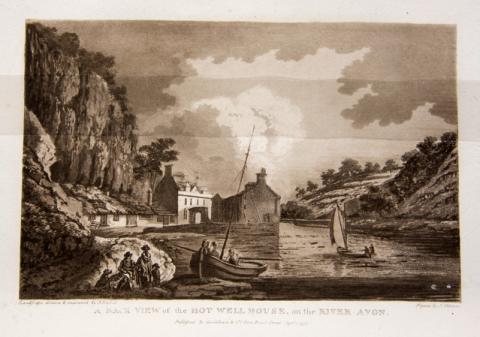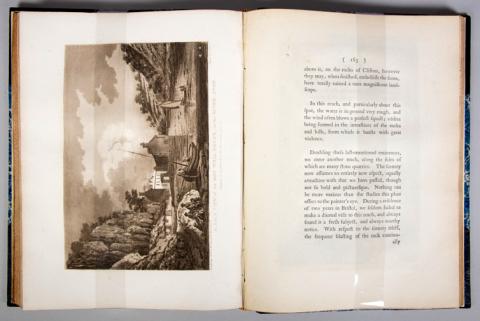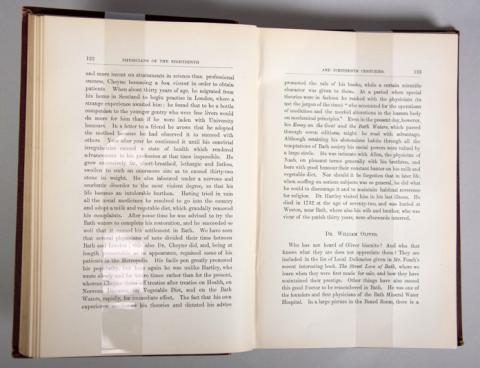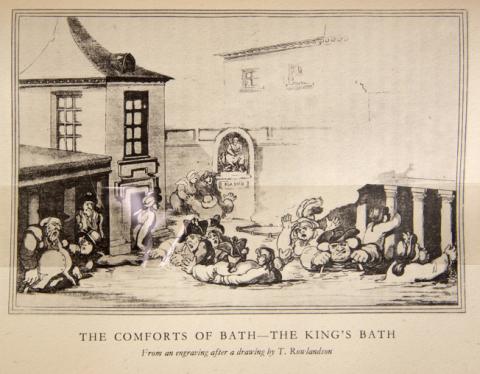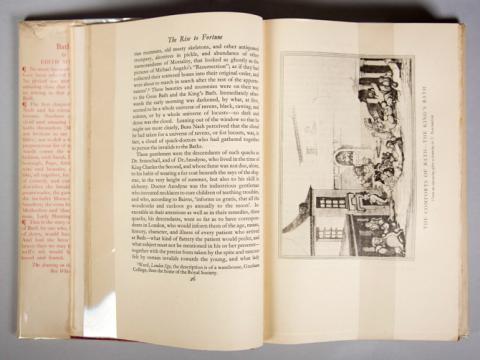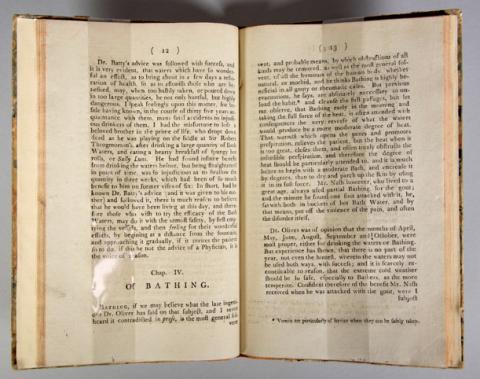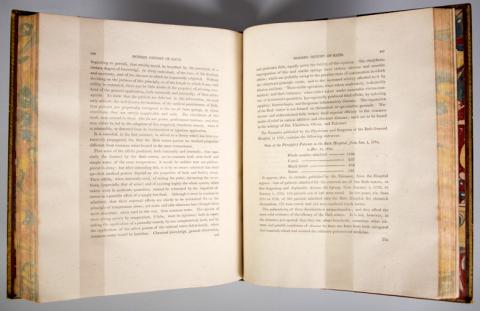Healing Waters of Bath, United Kingdom
One of the City of Bath's main attractions has been its famous spa water, which comes from hot springs in the area, the U.K.'s warmest geothermal springs. There is archaeological evidence of human activity in the Bath region in prehistoric times. There is a local legend about the discovery of hot springs here by the native peoples. Look at the label for the book by Pierce Egan in our display.
The Romans built a baths complex here ca. 60 A.D. during the time parts of the British Isles were part of their far-flung empire. They called the town Aquae Sulis. From the 17th century, people claimed the water had curative properties and Bath became a popular spa town, a place to live and vacation, to see and to be seen. In earlier eras, people believed bathing in and drinking such water contributed to good health.
Exhibits Bibliography
Click on image to see a readable PDF of the text, which will open in a new tab. Scroll down to read both pages. To return to the exhibit, click on the original browser tab.
- Allen, Benjamin. Natural History of the Chalybeat and Purging Waters of England, with Their Particular Essays and Uses, among which are Treated at Large the Apoplexy and Hypochondriacism, to which are Added, some Observations on the Bath Waters in Somersetshire…. 1699.
- SPC xx RM 674 .A45 1699
- We were not able to locate information about this author. His text shows the state of knowledge about hot springs and their curative properties in England at the end of the 17th century. How strikingly different it all is from our own day! We emphasize drinking a sufficient quantity of water per day to be healthy. We care a great deal about water purification, knowing that impure water carries “bugs” that transmit diseases. We worry about whether the planet will have enough of it. We worry about its adulteration from agricultural and lawn chemicals. We debate about the wisdom of “harvesting” Great Lakes water to bottle and sell. The author’s concern is about the contents of the water, how the appearance and texture of it changed depending on what he added to it and what uses, health-wise, it could be put to. He recognizes that why hot water bubbles out of the earth in certain places is a legitimate interest but this is not a topic he tackles.
- Elliot, John. Account of the Nature and Medicinal Virtues of the Principal Mineral Waters of Great Britain and Ireland, and Those in Most Repute on the Continent…. [1781].
- SPC Rare RA 846 .E45 1781
- John Elliot, 1747-1787, was a natural philosopher whose significance comes from his books and scientific papers in sensory physiology published 1780-1786. Scientists such as Elliot tried to understand how the senses of the body worked. At the beginning, this book talks about Joseph Priestley’s experiments on air and how a process he discovered might be used to give water certain healthful properties. Elliot’s training included an apprenticeship with an apothecary in London followed by work as an assistant in another practice. By 1780, he had his own business in Great Marlborough Street, London.
- This book is one of his “other publications,” a book for the general public. He discusses in detail the effects on the body of drinking and bathing in different kinds of mineral waters: chalybeate, chalybeate purging, sulphureous, sulphureous purging, acidulous, saline, saline purging, vitriolic. People flocked to Bath for its chalybeate waters, impregnated by or flavored with iron. People believed that chalybeate waters were the most beneficial kind; they are plentiful in the U.K. Depth of color indicated their strength. Most of the book is an alphabetical directory by place name of the English, Scots, Irish, and the most celebrated Continental places offering “water cures,” with information about the particular efficaciousness of them in each location. How drinking the waters of Bath worked in the body and what health problems Elliot and others thought would be ameliorated by doing so can be seen on the open pages here.
- Egan, Pierce. Walks Through Bath, Describing Everything Worth of Interest, Including Walcot and Widcombe, and the Surrounding Vicinity, Also an Excursion to Clifton and Bristol Hot-Wells, 1819.
- SPC DA 690 .B3 E2
- Pierce Egan, 1772-1849, was a sports journalist specializing in reporting on boxing matches. He also authored light-hearted guidebooks to several cities, including Bath, Liverpool, and Dublin. Shown here, in his guide to Bath, is the local legend (known in the 12th century) of the discovery of the hot springs at Bath by Bladud the Sage, son of an early British king, Lud Hudibras. Bladud was a leper. He escaped from “house arrest” at his father’s court, travelled into the country, and offered his service at a small village called Swainswick as a shepherd of pigs. He observed that the pigs, in both warm and cold weather, headed directly for a springs to wallow in the mud. He saw that their hides became smooth from rolling in the mud. He tried it himself; it cured him of his leprosy!
- Guidott, Thomas. Collection of Treatises Relating to the City and Waters of Bath….1725.
- SPC RA 850 .B3 G8 1725
- Guidott, 1638?-1706, was a physician and writer. He practiced medicine in Bath 1667-1679 and in London and Bath simultaneously from 1679. The work displayed is a collection of some of his writings on the topic of the healing waters of Bath. The first two pieces are on the history and the contents, properties, and distinction of each bath at Bath. The third piece is short biographies of 15 Bath physicians from 1598-1676. The fourth piece lays out the uses and abuses of warm water bathing and contains his reflections on fresh cold water bathing, bathing in sea water, and dipping used in baptism. The last piece is a hundred, paragraph length, observations from his 27 years of medical practice of the cures or benefits his patients received from the use of the waters of Bath. The open pages are from this last piece. Patients had palsy, gout, distemper, skin eruptions, sciatica, a sore-running-head, cramps and convulsive motions of muscles.
- Ibbetson, Julius. Picturesque Guide to Bath, Bristol Hot-Wells, the River Avon, and the Adjacent Country.... 1793.
- SPC DA 690 .B3 I2
- Julius Ibbetson, 1759-1817 was a landscape artist and watercolor painter. Shown here is his “Back View of the Hot Well House on the River Avon,” reminding us that there are hot springs in the area surrounding Bath, as well as in the town itself.
- Murch, Jerom. Biographical Sketches of Bath Celebrities, Ancient and Modern, with Some Fragments of Local History, 1893.
- SPC DA 690 .B3 M8
- Murch, 1807-1895, was a Unitarian minister in Bath and a municipal activist. He served as President of Bath Royal Literary and Scientific Institution, Vice President of Somerset Archaeological and Natural History Society, President of the Mineral Water Hospital and on boards of other civic organizations. He planned a comprehensive reform program for the town, to include building a modern municipal hospital with hot-water treatment baths, extension of the water supply, and solving river drainage and pollution problems. He championed the campaign to excavate the Roman baths in the City.
- This work contains history of Bath and chronological, biographical chapters on significant individuals associated with the City through time. The opened page contains the biography of George Cheyne, 1671/2-1743, a physician, who reports on his own positive health benefits from taking the waters at Bath. “After some time he was advised to try the Bath waters to complete his restoration, and he succeeded so well that it caused his settlement at Bath.” He encouraged his aristocratic and upwardly mobile patients to take responsibility for their own health by eating sensibly, drinking moderately, and bathing in warm springs.
- Sitwell, Edith. Bath. 1932.
- SPC DA 690 .B3 S5
- We know Edith Sitwell, 1887-1964, best as an English poet and critic. Her book, Bath, is a profile of the City under Richard (known as Beau) Nash, 1674-1761, a celebrated dandy best remembered as master of ceremonies of this spa town in his era. Pictured here are aristocrats bathing in the King’s Bath. Notice the sculpture of Bladud at the back of the scene.
- Thicknesse, Philip. Valetudinarians Bath Guide, or, the Means of Obtaining Long Life and Health…. 1780.
- SPC Rare RA 850 .B3 T45 1780
- Philip Thicknesse, 1719-1792, an army officer and travel writer, quarreled with practically everybody he knew. He lived in Bath off and on, married three times, fathered eight children, wrote several books about travel in France, and authored this guide to Bath. The pages open to display talk about what time of year is best to drink or bathe in the Bath waters, how the water works to open or close the skin’s pores, what time of day is best for bathing in the water, what temperature of water is best, and what health problems may be ameliorated by bathing in it.
- Warner, Richard. History of Bath. 1801.
- SPC DA 690 f.B3 W27
- Richard Warner, 1763-1857, was a Church of England clergyman and “antiquary.” In the U.K. an “antiquary” is a person who studies early history, relics, or monuments. He served in a church in Bath, 1795-1817, and in Chelwood, near Bath, 1833-1847; he was at other churches at other times in his ministry career. He loved the history of the Bath region, wrote a lot about it, and was a prominent figure in local society. His histories of Bath and Glastonbury were mostly syntheses of existing information. The pages on display, from his chapter “Of the Natural History of Bath and its Environs” summarize the thought of the time (c.1800) of the efficacy of the use of the waters of Bath for health reasons, referring to medical authors Drs. Charleton, Oliver, and Falconer. Information from the physicians and surgeons of the Bath General Hospital Report of 1787 gives some statistics on the medical outcomes of the patients treated there from 1776-1785.
Contact the Librarian
Agnes Haigh Widder, Humanities Bibliographer, A.M.L.S., M.A.
Michigan State University Libraries
366 W. Circle Dr. W118FF, Mail Stop 6
East Lansing, Mich. 48824-1048
(517) 884-6394
(517) 432-3532 Fax
widder@lib.msu.edu
http://staff.lib.msu.edu/widder/
Citation (Chicago):
Widder, Agnes Haigh. “Healing Waters of Bath, United Kingdom.” .” Michigan State University Libraries. Accessed [date of usage by patron]. https://lib.msu.edu/exhibits/healing-waters.


